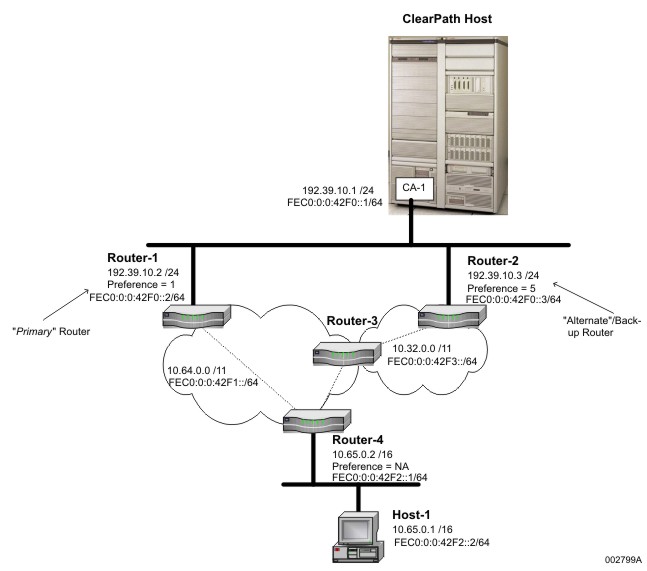You can use the ROUTE command in IPv4 or IPv6 networks to manually define multiple routes to a common destination such that access to the destination can be achieved through more than one next-hop router. By using a preference field, you can enable the routing software to bias some routes over others creating primary routes and alternate or backup routes.
This manual configuration (Alternate Route Topology) also gives you control over the network topology and its routing. By manually defining a resilient topology, you can allow dialogs to the same destination to use additional routes to those that can be learned from the network through RIP or IRDP (IPv4 networks) or through Neighbor Discovery (IPv6 networks). Defined static routes are also persistent routes and do not disappear due to route aging and other dynamic mechanisms operating within the network.
As shown in Alternate Route Topology, there are two possible routes from the ClearPath host to Host-1; one route via Router-1 and a second route via Router-2. The first route requires two hops (Router-1 and Router-4) while the second route requires three hops (Router‑2, Router-3, and Router-4). Router-1 is considered the "primary" route to Host-1 since it requires fewer hops.
In addition to allowing more than one route to the same destination, the ROUTE command provides you with the option to assign a route preference value to each route in order to specify the primary route and the alternate route. The route with the lowest preference value for a destination becomes the primary route (a value of 1 has a higher preference than a value of 2) and all routes with higher values (lower preference) become alternate routes according to their preference values.
In the topology example, Router-1 should be configured with a lower preference value (higher preference) in order to reflect the fewer number of hops to the destination, Host-1, while Router-2 should be assigned a higher preference value (lower preference) to represent the larger number of hops. This will make Router-2 the alternate router.
Since more than one route to a destination can now be configured, providing a preference with the route description enables the routing algorithm to determine the fact that one route is better than the other, thus biasing the first route over the second. Under these conditions, the second route would only be selected if the first route fails as detected by the Dead Gateway algorithm for IPv4 networks or by Neighbor Unreachability for IPv6 networks.


